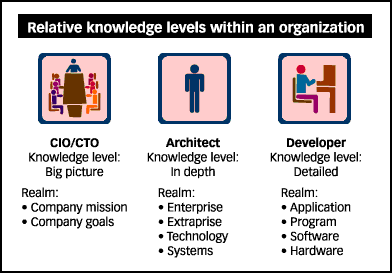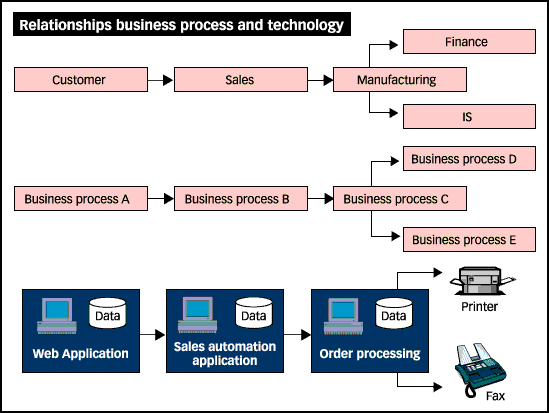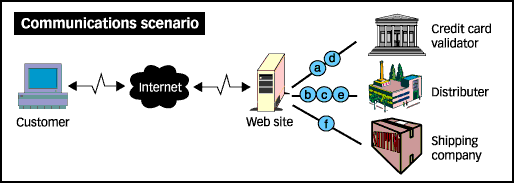The anatomy of the virtual corporation
Architecting in a world where outsourcing is becoming the rule
|
|
The anatomy of the virtual corporationArchitecting in a world where outsourcing is becoming the rule
|
The trend these days toward creating virtual corporations, companies whose business model involves the outsourcing of business functions, presents some interesting challenges for the IT architect. Technology, business processes, and relationships are all architected a little differently in these corporations. This month, Glenn Kimball discusses the partnerships to make and the pitfalls to avoid in architecting for this new kind of company. (3,100 words)
|
Mail this article to a friend |
Foreword
This month, I have asked my associate, Glenn Kimball, to write about his thoughts on being an IT Architect.Over the past few years, Glenn has worked on several large systems integration projects, many of which were Web-related.
Glenn's article demonstrates how to construct the business and technology models I described in my March column. Glenn refers to this type of working arrangement as a "virtual corporation." While my column covered business and technology models in broad strokes, Glenn talks about the factors to consider when you are actually doing the work.
--Kara Kapczynski
![]() lmost
every time you do something during your working day, whether you're buying a
hamburger or taking a call from a telemarketer, you establish a relationship
between a business and yourself. It might be as simple as picking up your
local paper or as complex as purchasing a home. Whatever the case, these
relationships form the cornerstone of our economy by providing convenience
and knowledge to customers.
lmost
every time you do something during your working day, whether you're buying a
hamburger or taking a call from a telemarketer, you establish a relationship
between a business and yourself. It might be as simple as picking up your
local paper or as complex as purchasing a home. Whatever the case, these
relationships form the cornerstone of our economy by providing convenience
and knowledge to customers.
But we seldom consider the actual machinations that go on behind the scenes to accommodate customers like ourselves.
Now, this is not to say that each of us has no exposure to a business process, but the majority of people in business today are just one part of an overall operation. Individuals tend to be masters of one domain (or business process) and are seldom masters of all domains. Even the upper echelons of management do not always have a complete understanding of all areas of their business. They generally rely on a concrete support structure to give them information; so too is it with architecture.

|
The virtual corporation
What is a virtual corporation?
Ask any two people and you will likely get two different answers. Ask more and you'll probably get a number of "I don't knows." Some people think of an organization with no buildings, facilities, or equipment; others think of an organization with which you will never have direct face-to-face contact.
In fact, there are many types of virtual corporation. On one side of the spectrum are organizations that may use catalogues to distribute sales information about their products but have their own manufacturing, design, sales, and marketing divisions. On the other side are organizations that only design and manage their product and leave all of the other functions to external partners (service companies or outsourcers). The level of virtuality will vary from organization to organization based upon the capacity or desire of the organization to perform different functions.
The keystone of today's virtual corporation is outsourcing, a concept that has been taken to its logical extreme, often through the use of the World Wide Web (WWW). A number of companies now almost exclusively deliver their marketing message and complete their sales cycle via computer-based means. Traditionally, many companies have worked with external organizations to support specialized human resource needs such as payroll (payment and taxation) and benefits -- 401(k) plans and insurance, for example.
What if I told you that there are organizations out there that outsource all of their functions except for management and marketing? The organizations that outsource at this level are likely to encounter all kinds of architecture issues at the business process, relationship, and technological levels.

|
ACME: A hypothetical virtual corporation
Say that a book seller, ACME Books Inc., has been in the book
selling business for several years and is considered the premiere
provider in the market. Throughout its history this company has
enjoyed a stable market that supported its income needs but
recently has been losing market share to a competing online book
store.
To combat this problem ACME has chosen to enter into the market space of the competitive bookstore. This means selling direct to individuals. In order to support this model, ACME finds that it will have to invest in new Web technology. ACME has a customer base that ranges from Fortune 500 companies to small businesses. Given the competitive pricing of its new sales initiative, direct sales via the Web has now become one of ACME's business goals.
ACME wants to act as upper management of all phases of the business and maintain an in-house selection organization, but the company does not want to invest in editorial, shipping, direct sales, or telemarketing with the new company footprint. In fact, it doesn't want ownership of any function other than leadership and selection. Part of its solution will leverage the World Wide Web to act as the main medium of sales and marketing. And by the way, did I mention that ACME wants to access the relatively untapped global market?
Business process factors
The fundamental building blocks of an organization are its business
processes and models, collectively referred to as the business
architecture of the organization. Business architecture represents
the collective understanding of how the business defines its
operations and pursues its mission.
Several things are immediately apparent about ACME. First, it is selling to the world and therefore must disseminate information to the world. Second, in order to facilitate the marketing and sales message, and sell books, ACME must provide a medium that gives prospective buyers the ability to identify, select, and pay for one or more books. Finally, we know the areas where ACME believes it is strong: management and selection.
ACME has made itself a tall order by working toward the virtual corporation model, especially given its level of outsourcing. In order to succeed, management needs to ask a number of important questions, including:
Although this list is not exhaustive these questions usually fall into one of the following categories:
An accomplished business architecture will focus on the optimal operations of the business while positioning the organization to achieve all of its goals. Here is a good set of rules to follow when designing the business processes of this type of organization:
|
|
|
|
|
Relationship factors
Relationships form the next major layer of the organization. In the
virtual corporation setting these relationships has even more
significance than in their classical counterparts. Relationships affect
all levels of the organization from both internal and external
perspectives.
In business we develop relationships at three levels. The first level is internally, where the communication and interrelationships within the organization occur. Next are the relations between the organization and its external partners. Finally, there are the relationships an organization develops with its customers. Our consideration for the virtual corporation focuses on the first two levels.
Productive relationships within the organization will be characterized by clear communication within the organization and between the organization and its external partners. The following items represent a good set of rules to work by when dealing with the relationships of the virtual corporation.
Technology factors
Technology is a major component of the virtual corporation model
because there is generally an overriding need to transfer information
within and between the organization and its partners (i.e. service providers).
Access to information is also of key concern to both customers and partners.
The following diagram depicts just one scenario related to the communications
issues that develop in a simple purchase process:

|
Ignoring the tools being used, the above situation represents a fairly basic scenario that most product-oriented businesses perform every day. In traditional organizations much of the communication described above would have taken place within the organization. In the virtual corporation many of these communications occur behind the scene and between distinct organizations via some sort of communications medium, such as electronic data interchange (EDI). Each communication step involves the development of interfaces to allow for the communication between the business and its partners to occur.
Technology is also a very important component when it comes to completing business processes to support the enterprise. Technology is not only the set of tools used to enable communication, it is also the tool that provides the customer experience and infrastructure behind the scenes. Architectural concerns here will center on several levels including user interface, middleware, and data while at the same time addressing overriding infrastructure needs.
An eye to the future
In many situations, it is the technologies that do not participate
directly with an application that get left by the wayside. Issues
such as security, replication, disaster recovery, and high availability
are often deemed to be less important than parts of the application itself
(interface, middleware, and data). Often this occurs at the
expense of the enterprise. Of even more concern is the tendency to
believe that all of these non-tier factors are easily retrofitted into any
system later in life.
A technical architect must not simply deal with the design and eventual implementation of different technologies to meet the systematic needs of the business. He must provide a foundation upon which to develop the future systems needs of the business. Here are my guiding principals for a successful technical architect:
The Web
The most recent development in our industry surrounds the World Wide Web.
Many organizations have begun to use the Web as a marketing and sales
medium because it represents a relatively untapped market. Organizations
that pursue this model tend to produce a smaller footprint (in terms of
the virtual corporation). Some perceptions and by-products of the Web
should be evaluated for validity.
First, most people assume that technological complexity has increased with the introduction of the World Wide Web. In reality, the Web is just another manifestation of client/server technology. Even though the fundamental technological complexity does not increase significantly, the number of integration steps do, and the relative newness of Web technologies can cause difficulties for organizations struggling to develop expertise.
|
technological complexity has increased with the introduction of the WWW. In reality, the Web is just another manifestation of client/server technology. |
Second, the relative look and feel of the Web (as compared to more classic client/server systems) has been responsible for the development of a number of boutique organizations dedicated to the design of the customer experience. This, in itself, is not fundamentally at issue, but when evaluating these types of organizations, you should look for the specific skills necessary to deliver both business and technological features.
Third, beware of organizations that claim they can implement all forms of technology as well as a number of specialty functions such as marketing and advertising. There are very few organizations out there that can accommodate this claim. The organization that does will provide such services as a concrete business offering rather than as a by-line service.
Finally, in the Web application arena there are many software organizations that focus on specific tool sets for the Web technology space but do not usually deal from an entire solution perspective. This is one of the fundamental truths that accompany the development of a new paradigm. As the public mindshare matures the tendency will be for smaller, less-capable companies to fall by the wayside. The exception to this rule may be those organizations that sell base-class frameworks and programming environments.
Be prepared
The virtual corporation represents just another phenomenon that
has begun to flourish with changes in economic motivators and tool
sets. Architecture within such enterprises is a funny thing. You won't find a complete architecture that is duplicated in any two independent organizations,
traditional or otherwise.
Given that the number of organizations that adopt this model will
continue to grow, be prepared to develop your skills in a
commensurate fashion. Also realize that your peers (as an architect
or at least future architect) are increasing in number. Most
organizations don't have just one architect (unless the organization
is relatively small). Instead, the architecture mindshare tends to
be distributed among a number of people.
![]()
|
|
Resources
About the author
![]() Glenn Kimball is a senior architect at Cambridge Technology Partners. His concentration within the company centers around
data architecture and its interrelationships with the enterprise.
Reach Glenn at glenn.kimball@sunworld.com.
Glenn Kimball is a senior architect at Cambridge Technology Partners. His concentration within the company centers around
data architecture and its interrelationships with the enterprise.
Reach Glenn at glenn.kimball@sunworld.com.
If you have technical problems with this magazine, contact webmaster@sunworld.com
URL: http://www.sunworld.com/swol-05-1998/swol-05-itarchitect.html
Last modified: